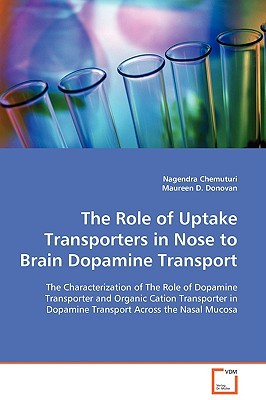
- We will send in 10–14 business days.
- Author: Nagendra Chemuturi
- Publisher: VDM Verlag
- ISBN-10: 3639114787
- ISBN-13: 9783639114782
- Format: 15.2 x 22.9 x 1.2 cm, softcover
- Language: English
- SAVE -10% with code: EXTRA
The Role of Uptake Transporters in Nose to Brain Dopamine Transport (e-book) (used book) | bookbook.eu
Reviews
Description
Dopamine, involved in the etiology of CNS related disorders such as Parkinson's disease, shows poor CNS disposition following oral and IV administration due to its extensive metabolism in the GI tract and poor permeation of the blood brain barrier. However, enhanced CNS uptake of dopamine was observed following intranasal administration. Western blotting and microscopy studies revealed the expression and presence of Dopamine Transporter (DAT) and Organic Cation Transporter-2 (OCT-2) in the nasal mucosa. Bi-directional transport studies demonstrated the role of both transporters in nasal mucosal dopamine transport. Taken together, these studies demonstrated the important role of both DAT and OCT-2 in dopamine uptake across the nasal mucosa. Nasal mucosal metabolism, which was also studied, of dopamine was small. So, nasal mucosal metabolism was not significant and does not limit nasal mucosal permeability of dopamine. The evidence from these studies suggests that enhanced CNS disposition of dopamine following nasal delivery is the result of carrier-mediated transport and is not significantly limited by nasal mucosal metabolism.
EXTRA 10 % discount with code: EXTRA
The promotion ends in 17d.21:44:55
The discount code is valid when purchasing from 10 €. Discounts do not stack.
- Author: Nagendra Chemuturi
- Publisher: VDM Verlag
- ISBN-10: 3639114787
- ISBN-13: 9783639114782
- Format: 15.2 x 22.9 x 1.2 cm, softcover
- Language: English English
Dopamine, involved in the etiology of CNS related disorders such as Parkinson's disease, shows poor CNS disposition following oral and IV administration due to its extensive metabolism in the GI tract and poor permeation of the blood brain barrier. However, enhanced CNS uptake of dopamine was observed following intranasal administration. Western blotting and microscopy studies revealed the expression and presence of Dopamine Transporter (DAT) and Organic Cation Transporter-2 (OCT-2) in the nasal mucosa. Bi-directional transport studies demonstrated the role of both transporters in nasal mucosal dopamine transport. Taken together, these studies demonstrated the important role of both DAT and OCT-2 in dopamine uptake across the nasal mucosa. Nasal mucosal metabolism, which was also studied, of dopamine was small. So, nasal mucosal metabolism was not significant and does not limit nasal mucosal permeability of dopamine. The evidence from these studies suggests that enhanced CNS disposition of dopamine following nasal delivery is the result of carrier-mediated transport and is not significantly limited by nasal mucosal metabolism.


Reviews